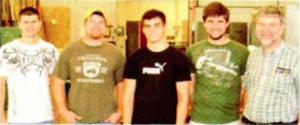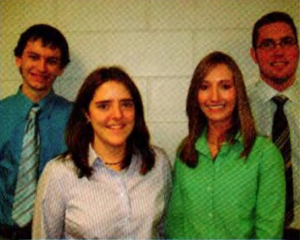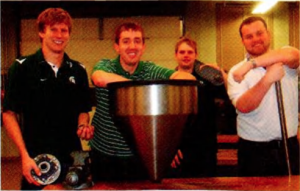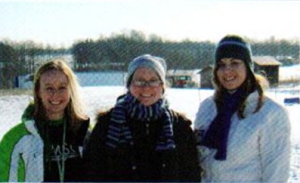Biosystems
Projects
Biosystems Engineering student teams, enrolled in the two-semester biosystems design capstone experience, BE 485/487, develop, evaluate, and select design alternatives in order to solve real-world problems. Projects are diverse, but each reflects systems thinking by integrating interconnected issues affecting the problem, including critical biological constraints. The engineering design process is documented in a detailed technical report. Teams present project designs to engineering faculty and a review panel of professional engineers for evaluation. Each BE 485/487 capstone design team prepares and presents a design solution in report, poster and oral formats to an industry advisory board, faculty, peers and the public that:
- Requires engineering design
- Uses a holistic approach
- Combines biology and engineering
- Interprets data
- Solves a real problem
- Evaluates economic feasibility
For information on sponsoring a project, please contact Dr. Dana Kirk or Dr. Luke Reese.
Urban Aquaculture
 Urban aquaculture can provide fresh seafood and jobs to local residents while showcasing the benefits of biologically sustainable solutions. The objective of this project was to develop a generic model that simulates an aquaculture system’s design requirements. Capital and operational costs were estimated to determine the feasibility of an aquaculture farm. The team then performed a case study on a facility in Detroit to determine the validity of the model.
Urban aquaculture can provide fresh seafood and jobs to local residents while showcasing the benefits of biologically sustainable solutions. The objective of this project was to develop a generic model that simulates an aquaculture system’s design requirements. Capital and operational costs were estimated to determine the feasibility of an aquaculture farm. The team then performed a case study on a facility in Detroit to determine the validity of the model.
A computer model was developed using Microsoft Excel. The model is based on species commonly used for fish farming including trout, catfish, yellow perch, and tilapia. By incorporating species specific information and allowing users to modify system parameters, accurate results are obtained. Specifications for a facility’s main components are determined including tank size, filtration rate, oxygen addition, water disinfection, and solids removal. Costs are estimated using up to date prices from manufacturers.
The model was tested to determine accuracy and ease of use for a site-specific case study. Results showed that the model is a useful tool for estimating the primary costs associated with developing a fish farm. A sensitivity analysis revealed that feed, fingerling, and energy prices have the greatest effect on cost.
Corn Drying Using Bio-based Fuels
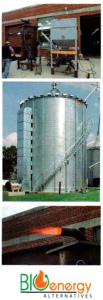 On-farm corn drying in the Midwest is primarily accomplished using propane as a heating fuel. The main objective of this project is implementing a biomass combustor to work in conjunction with a small-scale propane drying system (less than 60,000 bushels per season).
On-farm corn drying in the Midwest is primarily accomplished using propane as a heating fuel. The main objective of this project is implementing a biomass combustor to work in conjunction with a small-scale propane drying system (less than 60,000 bushels per season).
The project design is divided into four components:biomass combustion, heat transfer, grain drying, and emission filtration. Heat leaves the combustor at an average temperature of 1400°Fand enters an indirect contact heat exchanger. Clean air warmed to a fixed grain drying temperature enters the dryer. After heat transfer is achieved through a heat exchanger, combustion gases pass through a cyclone separator system to remove particulate.
Economic analysis revealed a substantial capital investment and extended payback period for the duel fuel system. Corn is dried for 3-4 weeks after fall harvest and the drying season cannot be increased without causing a substantial decrease in the quality of the com. However, two possible ways to reduce the payback period are: investigating off-season uses for the combustor and qualifying for government incentive programs. As propane prices increase, this project becomes more attractive.
E. Coli Monitoring and Detection in Recreational Waters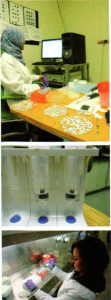
Escherichia coli (E. coli) is a bacteria used to indicate the presence of fecal matter. Using the standard detection protocol, Ingham County Health Department reports that E. coli levels have exceeded the current Michigan Department of Environmental Quality safety limits of 300 colony forming units per 100mL of sample within sections of the Red Cedar River.
The objective ofthis project is to develop a low-cost protocol that can be used to find the likely sources of E. coli impairment so that preventative techniques (best management practices) can be instituted. Identifying the source of the impairment will require that a substantial number of samples be collected and analyzed but the standard, regulatory method is expensive and requires substantial resources, limiting the number of samples that can be collected and analyzed. With the data from the simplified method, a statistical analysis can be conducted to determine likely locations o f the impairment.
Consequently, this project entailed developing a protocol with the following three components: water filtration to remove debris and concentrate bacteria. E. coli detection using an antibody- based biosensor, and statistical analysis the data to determine impacted regions of the Red Cedar River.
Developing Process Alternatives to Produce Consistent Meatless Burgers across Multiple Production Lines
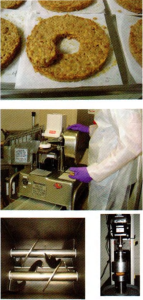 According to a North American Consumer Goods Company, alternatives to meat products such as meatless, soy-based, burgers are gaining popularity. Currently, the company utilizes a co-manufacturer for the production of meatless burgers on two processing lines. Line 2 produces burger batter with an acceptable quality while line 1does not pass quality control standards for regularity. To utilize line 1, additional ingredients are required to give the wet batter a consistency comparable to the acceptable batter, resulting in $80,000 of incremental costs each year. An alternative solution to achieve acceptable, consistent products from both lines utilizing the originally specified formulation is desirable. The objectives of this project were to characterize both production lines, identify potential causes for differences in product characteristics, and recommend process line modifications to enable the company to utilize the original meatless burger formula.
According to a North American Consumer Goods Company, alternatives to meat products such as meatless, soy-based, burgers are gaining popularity. Currently, the company utilizes a co-manufacturer for the production of meatless burgers on two processing lines. Line 2 produces burger batter with an acceptable quality while line 1does not pass quality control standards for regularity. To utilize line 1, additional ingredients are required to give the wet batter a consistency comparable to the acceptable batter, resulting in $80,000 of incremental costs each year. An alternative solution to achieve acceptable, consistent products from both lines utilizing the originally specified formulation is desirable. The objectives of this project were to characterize both production lines, identify potential causes for differences in product characteristics, and recommend process line modifications to enable the company to utilize the original meatless burger formula.
In order to accomplish these goals, the team visited the manufacturing plant to characterize both production lines. Pilot-scale mixing experiments were then performed at Michigan State University to determine the relationship between processing parameters and burger batter moisture content, water activity, and texture.
After determining relationships between processing parameters and batter characteristics, recommendations were proposed to improve the consistency of meatless burgers produced on line 1. A trial was conducted at the manufacturing plant to test the recommendations to produce meatless burgers that meet quality control standards.
Best Management Practice Recommendation for Escherichia coli in the Red Cedar Waters
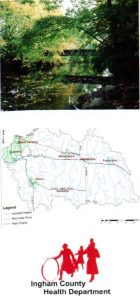 Parts of the Red Cedar River do not meet water quality standards because o f impairment with E.coli. The Ingham County Health Department requested a strategic plan that will restore the Red Cedar River to regulatory limits. This project determined point and non-point sources of excessive E. coli and developed a plan that will ultimately improve water quality.
Parts of the Red Cedar River do not meet water quality standards because o f impairment with E.coli. The Ingham County Health Department requested a strategic plan that will restore the Red Cedar River to regulatory limits. This project determined point and non-point sources of excessive E. coli and developed a plan that will ultimately improve water quality.
Determining the cause of pollution in the Red Cedar requires accounting for sources in the entire Red Cedar Watershed. The project used statistical analysis and watershed models to determine which areas likely contributed to high E. coli levels. This technique simulates hydrological processes and tracks the transport and die-off of bacteria throughout the watershed.
Best management practices, such as riparian buffers and rain gardens, are used to mitigate bacterial pollution before it reaches the river. These devices were entered into the watershed models to predict improvements to river water quality.
Bio-Fuel Source Optimization through Torrefaction
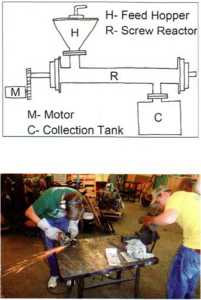 Michigan legislation calls for displacement of coal in power plants, requiring a percentage of energy be produced from renewable sources. Burning biomass is an option. However, biomass has a lower energy value than coal.
Michigan legislation calls for displacement of coal in power plants, requiring a percentage of energy be produced from renewable sources. Burning biomass is an option. However, biomass has a lower energy value than coal.
Torrefaction is a biomass pretreatment process which leaves 90% of the energy in 70% of the original mass. Additionally, producing torrefied biomass close to the point of collection concentrates the energy reducing shipping costs per unit amount o f energy produced.
There is a lack of experimental systems to test the torrefaction of biomass feedstocks. The project objectives were to design, fabricate, and test a pilot-scale torrefaction reactor. A protocol to test and compare the energy content of the torrefied biomass, raw biomass, and coal using a streamlined life cycle analysis was also developed.
A screw conveyor reactor was selected. Biomass is introduced to the system through a feed hopper and then proceeds through the reactor where torrefaction occurs. Torrefied biomass falls into a collection tank where it is allowed to cool. Thermocouples are used to monitor temperature at various points within the system.
Wastewater Treatment System Upgrade for a Small Cheese Producer
 A small-scale cheese producer who uses milk from local Amish dairies plans to expand production and thus produce a greater amount of waste water. To be proactive in accommodating the increase in wastewater, the company desires a new treatment system. Of great importance to the owner is to respect the Amish way of life and to maintain a less automated, more manual treatment system.
A small-scale cheese producer who uses milk from local Amish dairies plans to expand production and thus produce a greater amount of waste water. To be proactive in accommodating the increase in wastewater, the company desires a new treatment system. Of great importance to the owner is to respect the Amish way of life and to maintain a less automated, more manual treatment system.
Wastewater can pose serious human health risks and contribute to environmental degradation. Effluent from food processors typically have a high organic content, as indicated by biological oxygen demand (BOD).
Based on factors such as cost, treatment effectiveness, maintenance, energy requirements, and land use, a lagoon with an open sand bed gallery was selected as the treatment system. A lagoon is a shallow constructed pond that treats waste by sedimentation and bacterial activity. An open sand bed gallery contains small particles with high surface area in contact with the wastewater where a biofilm is cultivated. To design the system, several techniques were used, including a topographical survey, soil testing, wastewater characterization, and mathematical models. The completed design will be approved by Larry Stephens, a professional engineer, and then constructed on site.
Site Characterization and Design Plans for a Created Forested Wetland
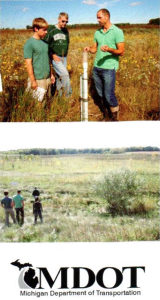 The Michigan Department of Transportation (MDOT) is at a deficit for wetland mitigation credit in the Maple River Watershed due to construction of the St. Johns Bypass on US 127. MDOT requested design plans for the creation of a forested wetland that is cost effective, innovative, and fits within the landscape.
The Michigan Department of Transportation (MDOT) is at a deficit for wetland mitigation credit in the Maple River Watershed due to construction of the St. Johns Bypass on US 127. MDOT requested design plans for the creation of a forested wetland that is cost effective, innovative, and fits within the landscape.
Through ArcGIS mapping and field surveys, the construction site was characterized to determine hydrology, topography, and soil classification. In order to determine the hydrologic regime of the system a water balance excel model was developed to predict inundation period and daily water height. Site design was optimized to minimize excavation, maintain wildlife usage, and ensure vegetative establishment.
Results of the water balance indicate sufficient water for a forested wetland ecosystem. Stop-log control structures and an earthen berm constructed from on-site soil are utilized to facilitate the necessity for precise water depths. The design includes small areas of emergent and scrub-shrub wetland to promote ecological diversity.
AutoCAD design drawings depict plan, cross-sectional, and structural component views. Specifications are provided for construction o f the site with details on required grading, vegetation planting, wildlife structures, and long-term monitoring.

